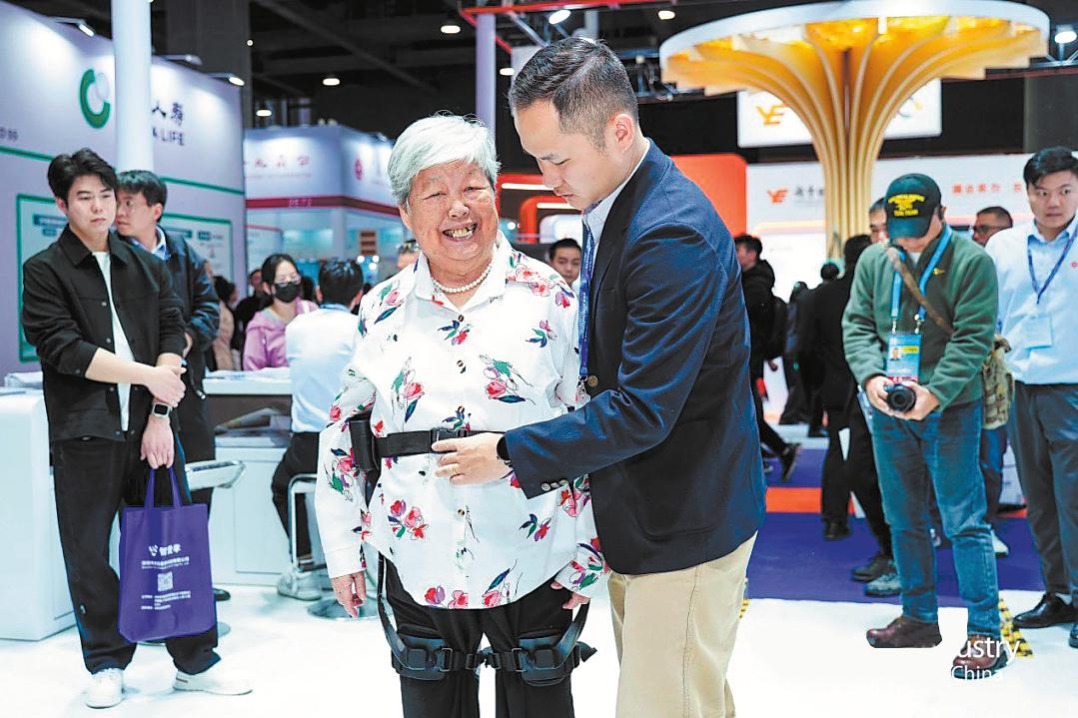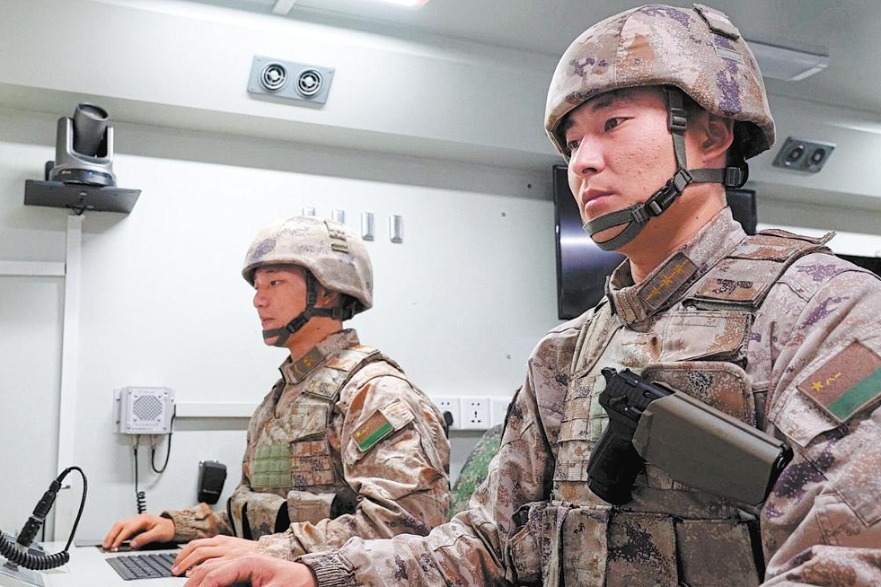Blaming China won't solve America's problems

Appendix
An Integrated Timeline of China's Early Response to COVID-19 & Interaction with WHO as Well as US Rhetoric and Actions on COVID-19
December 27, 2019: Zhang Jixian, director of the Department of Respiratory and Critical Care at Hubei Hospital of Integrated Traditional Chinese and Western Medicine, reported the first three suspected cases.
December 29: Related centers for disease control and prevention and hospitals in Hubei and Wuhan carried out epidemiological investigation.
December 30: Wuhan Municipal Health Committee issued an "urgent notice on the treatment of pneumonia of unknown cause".
December 31: The National Health Commission (NHC) sent an expert group and a working group to Wuhan to investigate on site and guide epidemic response.
December 31: The Wuhan Municipal Health Commission released a briefing on its website about the pneumonia outbreak in the city, confirming 27 cases and telling the public not to go to enclosed public places or gather. It suggested wearing face masks when going out.
Starting Dec. 31, 2019: the Wuhan Municipal Health Commission released briefings on the pneumonia outbreak in accordance with the law.
January 1, 2020: The NHC set up a leading group to determine the emergency response to the epidemic. The group convened meetings on a daily basis since then.
January 1: WHO had set up the IMST (Incident Management Support Team) across the three levels of the organization: headquarters, regional headquarters and country level, putting the organization on an emergency footing for dealing with the outbreak.
January 2: The Chinese Center for Disease Control and Prevention (China CDC) and the Chinese Academy of Medical Sciences (CAMS) received the first batch of samples of four patients from Hubei Province and began pathogen identification.
January 2: The NHC came up with a set of guidelines on early discovery, early diagnosis and early quarantine for the prevention and control of the viral pneumonia of unknown cause.
January 3: China started to send timely updates to WHO and other countries, including the US. China began to inform the United States of the pneumonia outbreak and response measures on a regular basis.
January 3: The Wuhan Municipal Health Commission updated briefing on its website about the situation of viral pneumonia of unknown cause, reporting a total of 44 cases of viral pneumonia of unknown cause.
January 4: Head of the China CDC talked over phone with director of the US CDC about the pneumonia outbreak. The two sides agreed to keep in close contact for information sharing and technological cooperation.
January 5: The Wuhan Municipal Health Commission updated briefing on the situation of viral pneumonia of unknown cause, reporting a total of 59 cases. Laboratory test results ruled out respiratory pathogens, such as influenza, avian influenza, adenovirus, the Severe Acute Respiratory Syndrome coronavirus, and Middle East Respiratory Syndrome coronavirus, as the cause.
January 5: China informed WHO about the outbreak updates.
January 5: WHO released its first briefing, Disease Outbreak News, on cases of pneumonia of unknown cause in Wuhan. Disease Outbreak News is a flagship technical publication to the scientific and public health community as well as global media. It contained a risk assessment and advice, and reported on what China had told the organization about the status of patients and the public health response on the cluster of pneumonia cases in Wuhan.
January 7: Xi Jinping, general secretary of the CPC Central Committee, made instructions on epidemic response when presiding over a meeting of the Standing Committee of the Political Bureau of the CPC Central Committee.
January 7: The China CDC succeeded in isolating the first novel coronavirus strain.
January 9: An expert team from the NHC made public of the pathogen, saying a new type of coronavirus was initially identified as the cause of the viral pneumonia in Wuhan.
January 9: China informed WHO about the epidemic, sharing with the WHO the initial progress in determining the cause of the viral pneumonia in Wuhan.
January 9: WHO released on its website a statement regarding a cluster of pneumonia cases in Wuhan, saying that preliminary identification of a novel coronavirus in a short period of time is a notable achievement.
January 10: Research institutions including the Wuhan Institute of Virology (WIV) developed testing kits. Wuhan City organized tests of all relevant cases admitted at hospitals in the city.
January 10: WHO issued a comprehensive package of technical guidance online with advice to all countries on how to detect, test and manage potential cases, based on what was known about the virus at the time. This guidance was shared with WHO's regional emergency directors to share with WHO representatives in countries.
January 12: The China CDC, the CAMS and the WIV under the Chinese Academy of Sciences (CAS), as designated agencies of the NHC, submitted to the WHO the genome sequence of the novel coronavirus (2019-nCoV), which was published by the Global Initiative on Sharing All Influenza Data (GISAID) and shared globally.
January14: WHO held a press briefing during which it stated that, based on experience with respiratory pathogens, the potential for human-to-human transmission in the 41 confirmed cases in the People's Republic of China existed: "it is certainly possible that there is limited human-to-human transmission".
January 18 and 19: The NHC assembled a high-level national team of senior medical and disease control experts and sent them to Wuhan to study the local response to the epidemic. In the middle of the night of January 19, after careful examination and deliberation, the team determined that the new coronavirus was spreading between humans.
January 19: The China CDC communicated with the US CDC on epidemic prevention and control.
January 19: Wuhan Municipal Health Commission updated the outbreak briefing on its official website, saying as of Jan. 17, Wuhan had reported a total of 62 confirmed cases, including 19 cases discharged after recovery, eight cases with severe symptoms, and two deaths.
January 20: Chinese President Xi Jinping made instructions on the outbreak of pneumonia caused by the novel coronavirus, including putting people's safety and health as the top priority, making thorough plans, taking effective measures to curb the spread of the virus, timely releasing information and deepening international cooperation.
January 20: The NHC held a press conference for the high-level expert team headed by Zhong Nanshan, who on the team's behalf confirmed human-to-human transmission of the novel coronavirus
January 21: The NHC started to update via its official website and its new media platform the epidemic information of the previous day on a daily basis. It had updated 71 times by March 31. Starting on Feb. 3, the English official website of the NHC started releasing epidemic information simultaneously, updating the data for 58 times by March 31.
January 21: A foreign ministry spokesperson said China will, upon invitation from the WHO, send representatives to attend an International Health Regulations (IHR) Emergency Committee meeting.
January 21: WHO published a statement on its official website saying that on January 20-21, a WHO delegation with experts from its China and Western Pacific regional offices conducted a field visit to Wuhan to learn about the response to 2019 novel coronavirus (2019-nCoV) and visited the Wuhan Tianhe Airport, Zhongnan Hospital, Hubei provincial CDC.
January 21: US CDC states that first travel-related case in US was confirmed in Washington state.
January 22: At the invitation of WHO, China attended an International Health Regulations (IHR) Emergency Committee meeting along with other countries affected by the epidemic. Participating countries, WHO and experts shared information on the epidemic and conducted scientific research and assessment of the epidemic at the meeting.
January 22: WHO mission to China issued a statement saying that there was evidence of human-to-human transmission in Wuhan but more investigation was needed to understand the full extent of transmission.
January 22: US President Donald Trump makes his first public comment about coronavirus while attending the Davos conference in Switzerland. "We have it totally under control," he tells the US cable channel CNBC. "It's one person coming in from China, and we have it under control. It's going to be just fine."
January 23: Wuhan was put under lockdown and unprecedented comprehensive, thorough and rigorous measures were adopted. By taking these decisive and strong measures, the Chinese government ensured to the highest possible extent the life and health of the Chinese people and bought precious time for stemming the global spread of the virus.
January 24: WHO Director-General Tedros Adhanom Ghebreyesus on social media thanked the Chinese government for its cooperation and transparency, saying that the Chinese government has been successful in isolating and sequencing the virus very quickly and has shared that genetic sequence with WHO and the international community.
January 24: The National Microbiology Data Center and the National Pathogen Resources Collection Center jointly established the Novel Coronavirus National Science and Technology Resource Service System, releasing the first electron microscope picture of the virus and strain information.
January 25: The NHC replied in a letter to WHO Director-General Tedros Adhanom Ghebreyesus, welcoming WHO to send a group of international experts to cooperate with China to strengthen epidemic prevention and control.
January 27: Under the joint prevention and control mechanism of the State Council, a press conference was held in Beijing to give briefings on the development of the community-based prevention measures to curb the novel coronavirus epidemic.
Such press conference had been held every day since Jan. 27, releasing updated data on a daily basis. As of March 31, 65 press conferences under the mechanism had been held on a wide range of topics, including the epidemic prevention and control, treatment and scientific research. Officials of 69 departments answered 779 questions raised by Chinese and foreign reporters at the conferences.
January 27: Joe Grogan, the head of the US White House domestic policy council, raises alarm telling the acting chief of staff, Mick Mulvaney, and others in a meeting that the fight against coronavirus would dominate public life for months and "the administration needed to take the virus seriously or it could cost the president his re-election", according to a Washington Post report.
January 28: US Secretary Azar delivers public remarks on coronavirus preparedness, assuring the public that the president is receiving multiple briefings each day and asserting that the readiness of the Strategic National Stockpile is being assessed.
January 28: A senior WHO delegation led by the Director-General travelled to Beijing to meet China's leadership, learn more about China's response, and to offer any technical assistance. While in Beijing, Dr. Tedros agreed with Chinese government leaders that an international team of leading scientists would travel to China on a mission to better understand the context, the overall response, and exchange information and experience.
January 30: China's NHC notified the US side that American experts are welcomed to join the China-WHO joint mission. The US side responded the same day and expressed their appreciation.
January 30: The China CDC published a paper in the New England Journal of Medicine, titled "Early Transmission Dynamics in Wuhan, China, of Novel Coronavirus-Infected Pneumonia," revealing the epidemiological characteristics of the 2019-nCoV on the basis of data collected from the first 425 confirmed cases.
January 30: WHO declares the novel coronavirus outbreak (2019-nCoV) a Public Health Emergency of International Concern (PHEIC). WHO's situation report for January 30 reported 7818 total confirmed cases worldwide, with the majority of these in China, and 82 cases reported in 18 countries outside China. WHO gave a risk assessment of very high for China, and high at the global level.
January 30: As WHO declares a global health emergency, US Secretary Azar directly warns President Trump about the looming threat during a call with the president, the second warning he delivered to the president about the virus in two weeks. Taking Azar's call aboard Air Force One en route to a campaign rally, Trump dismisses him as "alarmist", the New York Times reported.
January 31: Speaking from the news briefing room at the White House, US Secretary Azar announced that the coronavirus presented a public health emergency. "The risk of infection for Americans remains low," Azar added. "And with these and our previous actions, we are working to keep the risk low."
January 31: President Trump issues Proclamation 9984, suspending entry for foreign nationals who had traveled in Chinese mainland in the past two weeks.
February 2: Head of China's NHC Ma Xiaowei sent a letter to the US Secretary Azar, further exchanging views on bilateral cooperation in health as well as epidemic prevention and control.
February 3: Officials of the China CDC welcomed a US expert from the Columbia University.
As of Feb. 3: China has given the United States briefings on the epidemic information and control measures in China for 30 times, including sharing with US CDC project manager in China information about China's diagnosis and treatment guidelines, prevention and control guidelines, and the linkage of the novel coronavirus database that China shares with the world in real time.
February 4: Head of the China CDC spoke over phone with director of the US National Institute of Allergy and Infectious Diseases to exchange information on the epidemic.
February 4: US FDA grants Emergency Use Approvals (EUAs) to CDC-qualified laboratories to test for coronavirus using the test kits developed by the CDC, limited to patients who meet CDC criteria for testing; test validation work begins thereafter.
February 5: Chinese foreign ministry hosted the second briefing on the novel coronavirus pneumonia outbreak for diplomatic missions in China. The briefing was held online and attended by representatives of more than 180 diplomatic missions. Officials from the NHC and the foreign ministry gave briefings on the epidemic situation and the containment measures taken by the Chinese government, and answered questions of concern to the diplomatic envoys.
February 8: Chinese, US health authorities had another discussion over arrangements regarding the participation of American experts in the China-WHO joint mission.
February 10: An advance squad of the WHO-led team arrived in Beijing.
February 10: Experts from the China and US CDCs held a conference call, discussing and sharing epidemic prevention and control information.
February 12: US CDC reveals that its testing kits were flawed, leading many authorized labs to have difficulty validating them because of problems with one of the reagents.
February 14: Michael Ryan, executive director of the WHO health emergencies program, refuted remarks by Lawrence Kudlow, the director of the White House National Economic Council, that described the Chinese government's response to the epidemic outbreak as lacking transparency. Ryan said the remarks did not accord with the facts, as the Chinese government actively cooperated with WHO and displayed a high level of transparency.
February 16: The China-WHO joint expert team started a nine-day field visit in China, scheduled to inspect cities including Beijing, Chengdu, Guangzhou, Shenzhen and Wuhan. The delegation, which included experts from Canada, Germany, Japan, Nigeria, Republic of Korea, Russia, Singapore and the US (CDC, NIH) spoke with health officials, scientists and health workers in health facilities.
February 19: Addressing a group of governors, US President Trump predicts the virus will disappear. "I think it's going to work out fine. I think when we get into April, in the warmer weather, that has a very negative effect on that and that type of a virus."
February 22: US CDC officials tell states that only symptomatic patients with travel histories in Chinese mainland were to be tested.
February 24: Across China, the number of existing confirmed cases had dropped for nearly a week, while the daily number of newly cured and discharged COVID-19 patients was no less than that of new confirmed infections in all provincial-level regions.
February 25: At a news conference in New Delhi, President Trump says: "You may ask about the coronavirus, which is very well under control in our country. We have very few people with it."
February 25: Larry Kudlow, the director of White House national economic council, is asked about Director of the Center for the National Center for Immunization and Respiratory Diseases Messonnier's comments on CNBC. "We have contained this," he says. "I won't say airtight, but it's pretty close to airtight."
February 25: US CDC announces that the pandemic is likely to spread to the United States and will make various mitigation measures necessary.
February 26: "The infection seems to have gone down over the last two days," President Trump says at a White House news conference. "We're going to be pretty soon at only five people. And we could be at just one or two people over the next short period of time."
February 26: US President Trump announces that Vice President Pence will now lead the White House Coronavirus Task Force.
February 26: US CDC emails state and local officials to tell them its "testing capacity is more than adequate to meet current testing demands."
February 26: US CDC announces what it believes may be an instance of community spread in California: "the first time this has happened in the United States." Reporting indicates that the patient sought a test on February 19 but was initially rebuffed because of not matching existing testing criteria.
February 27: "It's going to disappear," President Trump says in a White House briefing. "One day it's like a miracle, it will disappear."
February 28: US CDC widens testing criteria to those with foreign travel in Italy, Iran, Japan, and South Korea, as well as those with respiratory failure severe enough to cause hospitalization regardless of travel.
February 29: US FDA announces that public and private labs could use non-approved tests and seek retroactive approval.
March 2: US FDA Commissioner Stephen Hahn says that "by the end of this week, close to a million tests will be able to be performed."
March 5: According to US CDC, confirmed US cases pass 100.
March 11: WHO made the assessment that COVID-19 can be characterized as a pandemic.
March 11: According to US CDC, confirmed cases in US pass 1000.
March 11: US President Trump addresses the nation in a televised address, saying that "we are marshalling the full power of the federal government and the private sector to protect the American people" and announcing a number of new actions, including a ban on European entries and an agreement with American insurers that copays for coronavirus testing and treatment will be waived.
March 13: US President Trump declares a national emergency, and also announces close cooperation with private sector leaders to enable mass private testing.
March 18: According to US CDC, confirmed cases in US pass 10,000.
March 26: The Lancet's editor Richard Horton said on BBC that "the message from China is very clear...we wasted February when we could have acted...it is a national scandal".
March 31: The journal Science published a paper authored by researchers from the United States, the UK and China saying that China's control measures worked by successfully breaking the chain of transmission and bought other countries valuable time to prepare for the outbreak.


































